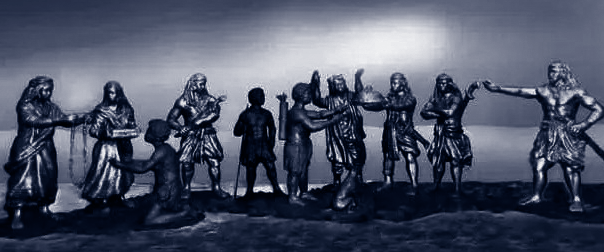How 10 Bornean chiefs ended up founding villages in pre-colonial Philippines

Decades past, skepticism shadowed the authenticity of Maragtas and its authorship until, gradually, scholars began to piece together the narrative's validity. Maragtas chronicles the early history of Panay (Aninipay) island of the Philippines, detailing how a group of chiefs from Borneo fled the despotic rule of Raja Makatunao and resettled on the island, later spreading to other parts of the archipelago.
Penned by Pedro Alcantara Monteclaro in Hiligaynon and Kinaray-a languages, Maragtas drew from a blend of written records and oral traditions available to Monteclaro at the time. Esteemed anthropologist William Henry Scott endorsed the work as Monteclaro's own, and even esteemed ethnologist Dr. H Otley Beyer, dubbed the "Dean of Philippine ethnology, archaeology, and prehistory," lauded it as a "remarkable document."
An article in A.V.H. Hartendorp’s magazine in the 1930s refrained from delving into the historical accuracy of the tale; rather, it presented the story as is, devoid of embellishments or personal biases.
"The Settling of Panay by the Seven Datos of Borneo" by Percy A. Hill retold the saga of Marikudo of Aninipay and the transaction that ceded a vast expanse of the island to the Bornean datos for their settlements.
Here is the roster of the "datus" or "datos" as mentioned in Hill’s account: Dato Paiborong and his wife Pabulan; Dato Puti and his wife Pinagpañgan; Dato Sumakuel and Kapingañgan; Dato Bancaya and Katurong; Dato Paduginug and Ribang Sapaw; Dato Dumangsil and Kabiling; and the single chiefs Dato Lubay, Dato Dumalugdug, and Dato Kalinsuela.
Hill, regrettably, overlooked one chief: Dumangsol.
According to the tale, fleeing from the tyranny of Raja Makatunao, the datus, their families, and slaves departed from Borneo on their "balangay" or dugouts with bamboo outriggers called "batangas". Navigating along the coast of Palawan and its islets, they eventually reached Cuyo, where they caught sight of the mountains of Aninipay. There, they docked near the Sirwagan River, in the town of San Joaquin, where Negritos led by Marikudo had taken refuge.
Spotting a local fisherman near their landing site, the Bornean seafarers approached him and persuaded him to lead them to their leader. With the aid of a guide familiar with the island and fluent in the language, they met Marikudo and explained their predicament. Led by Datu Puti, the chiefs bargained with Marikudo for the purchase of land, preferably near the river and the sea. Marikudo requested time to deliberate on their offer, consulting with the elders.
The elders willingly relinquished their settlement in the plains in exchange for a rancheria in the mountains, where they would be less vulnerable to attacks compared to their proximity to the water.
Hill juxtaposed the Borneans and the indigenous group, noting differences in attire. While the aborigines were described as clad in something "primitive," Hill depicted the chiefs wearing vests paired with brightly colored sarongs that reached the knees. He described:
Each carried a decorated kris or barong belted to his waist, and a sort of satchel, made of deer or musang skin, held lime, betel, and chewing materials, flint and steel, and other small necessities. They wore their hair long, and the datos and sacops adorned their heads with a crimson cloth drawn to a high point called a potong. The women wore short-sleeved jackets upon which were sewn trinkets and bright shells, with a double sarong, the outside one falling to the ankles, strings of glass or gold beads, bracelets of brass, copper, or gold according to their rank, and rings on both hands and feet, while their hair was oiled and parted in the center, very different from the frizzy-haired and almost naked Negritos.
At a feast hosted by the aborigines, the terms of the transaction were settled. Fully armed and attired for the significant occasion, the foreign visitors dazzled their hosts. Datu Paiburong presented Marikudo with a kris featuring a handle crafted from burnished copper.
Moreover, before proceeding with the account of the negotiations, Hill mentioned that the old manuscript placed heavy emphasis on the acquisition of the entire island, with the value of the gifts exaggerated, "even allowing for the weight in ounces, de escudo Castellano, of the various articles." Hill surmised that it was more plausible that the vague gestures of the Negrito elders and Marikudo led the datos to believe that the entire island was included, rather than a specific district with defined boundaries.
Datu Puti extended their offer, which included gold-plated salakot (hat), hatchets, knives, beads, garments in three colors, and the basin, deemed the most valuable of all. Even the gold beads adorning Puti’s wife became part of the agreement. As an added concession to the Borneans, the aborigines pledged to supply them with fish and materials for their new settlement.
With the transaction concluded, Puti resolved to return to Borneo, entrusting the leadership of the group to Sumakuel. En route northward, they made a stop in Taal, Batangas, where Dumangsil and Kalinsuela established their own settlements.
Furthermore, Puti journeyed back to Borneo, where he managed to persuade more people to embark on new frontiers, akin to their discovery of Aninipay and Taal.
Upon their return to Aninipay, the island was divided into three regions: Hantic, with Sumakuel as paramount chief, supported by Lubay, Dumalugdug, and Paduginug; Acklan, ruled by Sumakuel’s brother-in-law Datu Bancaya; and Irong-irong, governed by Paiborong.
Centuries later, with the arrival of the Spaniards, the island became known as Oton. Its fertile plains consistently yielded abundant harvests, giving rise to the Spanish expression "pan hay en esta isla" — later abbreviated to "Panay." Hantic (ferocious ants) evolved into "Antique."